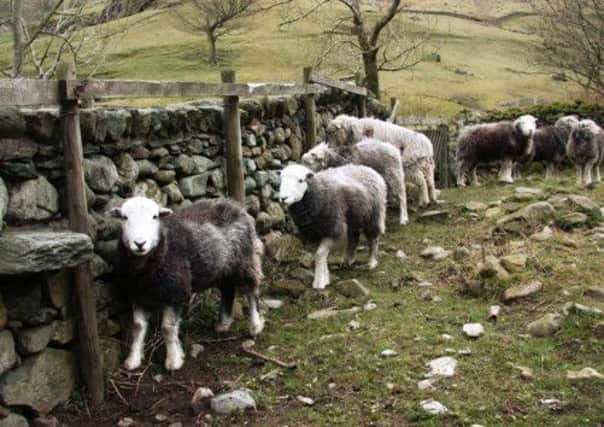A breed with trust in a strong future


Back in 2001, many Herdwick farmers were desperate. Foot-and-mouth disease had led to the destruction of thousands, sometimes entire flocks, of these hardy sheep, in pyres and mass graves.
Of the estimated 75,000 present before, more than 30,000 Herdwicks were lost during the epidemic. There was genuine concern for the survival of the breed.
Advertisement
Hide AdAdvertisement
Hide AdNow, 12 years on, the Herdwick’s future seems assured. Herdwick meat, already prized for its distinctive flavour, is about to be awarded protected designation of origin, and is increasingly being promoted as special by retailers and chefs.
The breed is better known than ever, largely because of its long-standing association with the Lake District, and to innovative Herdy products. Jamie Oliver has adopted Herdy kitchenware for his Jamie at Home range, and distributors are taking the products as far afield as Japan and the US.
And the Herdwick Sheep Breeders’ Association, which will be 100 years old in 2016, has become an industrial and provident society, an organisation legally recognised by the government.
With support from the Co-operative Enterprise Hub, the association now has a business plan and a new constitution, and is stronger than ever.
Advertisement
Hide AdAdvertisement
Hide AdIt was Herdwick breeders’ response to foot and mouth disease that helped ensure preservation of not only the Herdwick breed, but also other breeds at risk.
At the height of the epidemic in 2001, Herdwick breeder Andrew Nicholson contacted Professor Dianna Bowles, a plant biologist at the University of York, for help. Prof Bowles was well-known as a Herdwick breeder, and keeps her own flock in Nidderdale.
“That phone call from Andrew began a chain of events that ultimately led to the foundation of The Sheep Trust, now a national charity based at The University of York,” she says.
She organised a specialist team of vets who worked with Herdwick breeders in Cumbria and local vet Amanda Carson to collect germplasm – semen and embryos – from flocks at risk.
Advertisement
Hide AdAdvertisement
Hide AdDianna, who chairs the trustees of the Sheep Trust, says: ‘The Herdwicks led the way in setting up the first national gene bank for sheep. As the disease epidemic spread, more breeds’ germplasm were collected to conserve their resources too.
“For a time, back then, hope was lost from the farming community, but time heals and the Heritage Gene Bank continues as a reminder of how science did and can continue to help farming and the heritage of sheep in our countryside.”
The Sheep Trust confirmed the viability of its gene bank when it used semen from Andrew’s rams to inseminate six of his Herdwick ewes. The lambs these ewes bore in 2011 were offspring of the rams he lost to a cull in 2001.
Herdwick embryos from the bank were put into surrogate mothers of a different sheep breed. The surrogate mothers gave birth to Herdwick lambs, 10 years after they were conceived. Six months later the trust returned by the trust to their original breeders in Cumbria and today they are about to produce their own lambs.
Advertisement
Hide AdAdvertisement
Hide AdThe trust went on to raise awareness of the danger facing local breeds like Herdwicks. It proved 12 sheep breeds in the UK, including Rough Fell, Dalesbred and Lonk, are highly concentrated in a single geographical region.
More than 95 per cent of all Herdwicks, for example, are with about 20 miles of Coniston in the Lake District. Prof Bowles says: “These breeds aren’t rare. There can be tens of thousands of animals that are commercially farmed. But when they’re almost all in one place they’re hugely vulnerable if an infectious disease enters their homeland.”
Whilst Defra now recognises the Herdwick is at risk, the breed is not included under European disease control legislation which allows member states to spare animals from culling, provided disease control is not compromised. The HSBA is campaigning to change this.
Meanwhile, Herdwicks are becoming an increasingly popular choice for breeders outside the Lake District. In Yorkshire, for example, six flocks have strong links and are HSBA members, including Prof Bowles’s flock in Nidderdale.
Advertisement
Hide AdAdvertisement
Hide AdHSBA secretary Amanda Carson says one of the best ways farmers and smallholders can support Herdwick farmers is to buy their draft ewes. “The draft ewes have bred replacement Herdwick lambs but still have enormous potential to produce fantastic and profitable cross bred lambs,” she says.
“Herdwicks are hardy and when put on to better grazing than the fells can produce twins and triplets. They’re long lived so are a sound investment for farmers who buy them for crossing.
“They’re small too, so the mothers graze less than a commercial ewe, which further increases the profit margin; less grass for the mothers and more for the lambs.
“They’re good mothers and require less commercial input than commercial ewes.”
Herdwick faces
Advertisement
Hide AdAdvertisement
Hide AdPurebred Herdwick lambs are born black, but as they age their heads and legs become white and their fleece goes grey. Most Herdwicks over-winter on unfenced fells, including large areas of common land, without supplementary feeding. The ewes stay in their “heaf”, the same small area of fell. Herdwicks have outer jackets and inner waistcoats; characteristics still found in wild sheep. Their coats have hairy white fibres which shed water and do not absorb dyes, giving Herdwick cloth its particular character
Traditionally used for carpets, Herdwick wool is now also used in insulation.